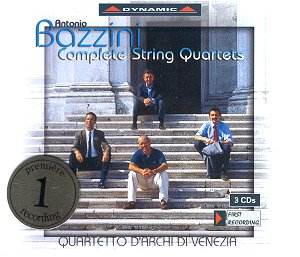If the name of Antonio Bazzini means anything to you,
it is probably as the composer of "Rondes des Lutins", a devilishly
difficult but wonderfully effective encore piece for violin and piano.
If this leads you to expect a Paganinian concept of chamber music, i.e.
pyrotechnics for the first violin and mere vamp for the other three
players, then youíre in for a surprise.
During the first part of his career Bazzini was a much-travelled
violinist, visiting Germany, Denmark, Poland, Spain and France, where
he remained from 1852 to 1863. He enjoyed the esteem of Paganini, but
also that of Mendelssohn and Schumann, hardly the men to applaud empty
virtuosity, and versed himself thoroughly in the Northern European instrumental
styles of his day. On his return to Italy in 1863 he dedicated himself
to composition. His only opera, Turanda (La Scala, Milan, 1867),
enjoyed no success, but his real mission was to bring Italian instrumental
music, and particularly chamber music, in line with that of Germany
and Austria. He composed a certain amount of orchestral music (no symphony),
four violin concertos, a string quintet and the present six string quartets,
together with much music for violin and piano. He was also involved
in several initiatives to bring chamber music before a public whose
listening habits were almost exclusively operatic. So Martucci and Sgambati,
generally credited with the revival of Italian instrumental music, did
not start entirely from zero. Bazzini was appointed professor of composition
at Milan Conservatoire in 1873, where he counted Catalani and Puccini
among his pupils, and rose to be director in 1882. The Milan civic authorities,
in accordance with the Italian custom of naming streets after famous
national figures, honoured him with a Via Bazzini in a slightly off-centre
part of the town, with Via Catalani, Via Pacini, Via Porpora, Via Frescobaldi,
Via Boccherini and Via Lulli all in close walking distance.
It is evident from the first two quartets that this
is genuine quartet writing, with interest well distributed between the
four parts and a clear-cut sense of form. The music sounds more Germanic
than Italian and there is little harmonically to suggest that it they
were written several decades after the death of Schubert. If you get
the idea I am damning them with faint praise Iím afraid I do feel these
first two works are to be more admired than loved. It is as though Bazzini,
intent on demonstrating his mastery of the String Quartet (with capital
letters) had omitted to fill the framework with actual music.
The third quartet, however, is a richly sonorous, purposeful
and strongly felt work, well worth the attention of quartets wishing
to enlarge their 19th Century repertoire. In the remaining
three works Bazzini continues to demonstrate his acquired mastery with
a certain relaxed fluency but does not find again the genuine inspiration
of no. 3.
I filled in the picture a little by reminding myself
of a few other works I had by Bazzini on off-the-air tapes. When a piece
by Bazzini is revived in his native country (which is not often), it
is usually the String Quintet, and I am not surprised, for it is a delightfully
spontaneous work with an expansive, heartfelt slow movement and a tarantella
finale which for once shows that Bazzini was Italian after all. It was
also these broadcast performances which led me to question the undoubtedly
excellent performances on the present three CDs. The Quintetto Boccheriniís
1962 performance of the Quintet is pretty untidy at times but it has
a verve and a rhythmic élan that I donít anywhere in the Venetian
groupís work; the latter stress the classical serenity of the music.
I am undecided as to whether the difference derives from the Quintetto
Boccherini itself or the music they had to play, but I have no doubt
that Aldo Ferraresiís performance of the Fourth Violin Concerto is a
model of how to breathe life into lesser music. Little known abroad,
Ferraresi (1906-1978) was a major figure in post-war Italian music making.
A pupil of Ysaye, he inherited his masterís warmth of tone and his alternation
of brilliance, depth of feeling and sheer range of tonal variation succeeds
in banishing doubts as to the quality of the music (doubts which surface
again during the orchestral interludes). If anyone feels like commemorating
Ferraresi, I hope they will keep this 1961 performance in mind.
Finally I heard Bazziniís symphonic poem Francesca
da Rimini, which shows he could write for the orchestra as effectively
as for strings, but which relies on rather stock Lisztian gestures to
build up the tension, only to dissipate it with some rather pallid love
music.
I suppose these three CDs are intended for specialists.
If anyone had the bright idea of issuing a disc which couples the Third
Quartet with the Quintet the result would be of much wider interest.
The Quartetto díarchi di Venezia reserve their finest performance for
the Third Quartet, suggesting that they, too, felt it to be the one
really inspired work here. The recording is excellent and the booklet
notes contain plenty of useful information.
Christopher Howell

